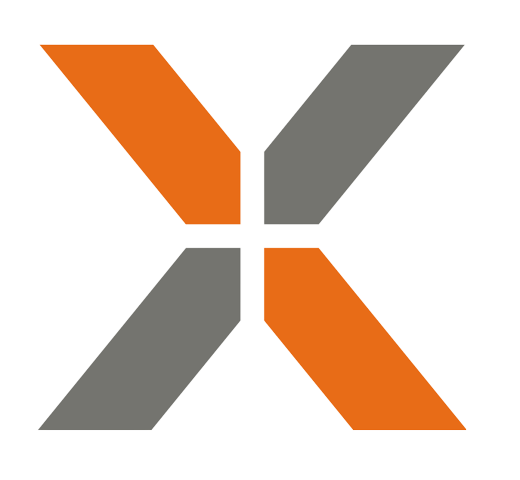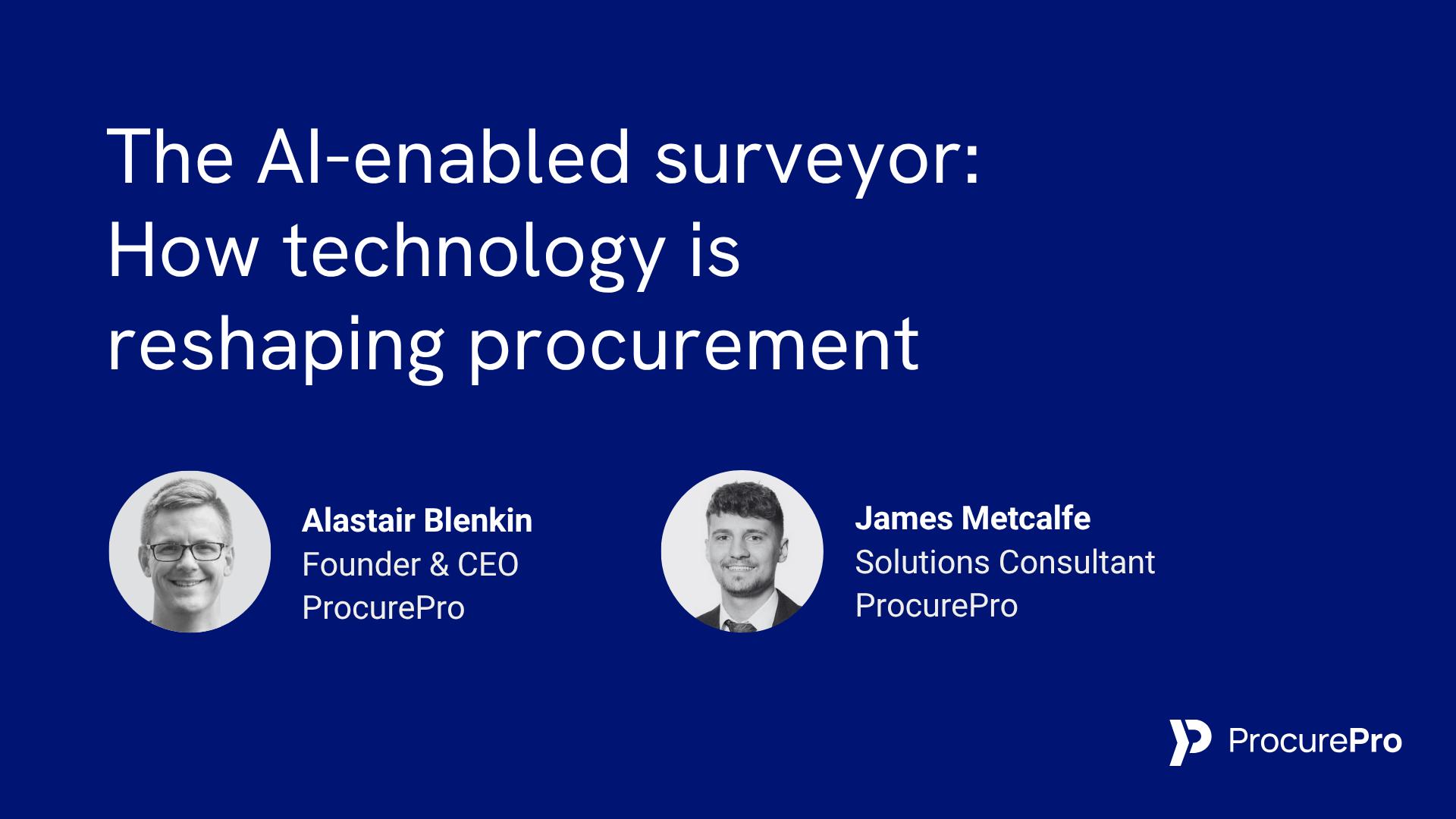AI isn’t on its way, it’s already here. It’s overhauling how construction procurement works, from pre-tender scoping to contract sign-off.
In a recent webinar, commercial leaders Alastair Blenkin and James Metcalfe showed how real teams use AI to reduce admin, make more informed decisions on pricing, and avoid the procurement traps that erode margin.
For more insights on how analytics can help you make smarter buying decisions, explore our comprehensive guides.
The current state of AI adoption in construction procurement
"The industry is shifting rapidly towards smarter, AI-driven procurement strategies." — Alastair Blenkin
Construction is starting to catch up to other sectors in AI adoption. Most commercial teams, however, are still tied to spreadsheets, email threads, and gut instincts.
AI is beginning to surface in the background, especially in companies using it to review subcontractor pricing, track performance, or pull insights from scattered data. Adoption is patchy because standardisation remains a major hurdle. One project might use structured vendor data, while the next relies on PDFs buried in inboxes. For a deeper dive into how AI is revolutionising the sector, check out AI in construction.
Why procurement is pivotal for construction success
Procurement influences 80–90% of a contractor's total spend. It shapes commercial performance and impacts how well a project runs once work begins.
"Procurement data looks forward, allowing you to proactively shape outcomes." — Alastair Blenkin
Cost reports show you what happened. Procurement data shows what’s coming next. If you see a subcontractor quote that’s 20% higher than the others, follow up and ask why before you lock in contracts. Explore risk management to navigate challenges effectively.
AI surfaces red flags early. It flags patterns, spots anomalies, and prompts better questions.
Challenges of traditional procurement methods
Fragmentation and manual inefficiencies
Procurement typically breaks down at multiple points. A single trade package might pass through 20 steps before it’s awarded. Scopes live in Word docs, tenders in email threads, approvals on paper, and contracts in PDFs. Everyone has their own spreadsheet. No one sees the whole picture.
"Manual processes slow projects down and drain profitability." — James Metcalfe
The 12 Problems of Procurement
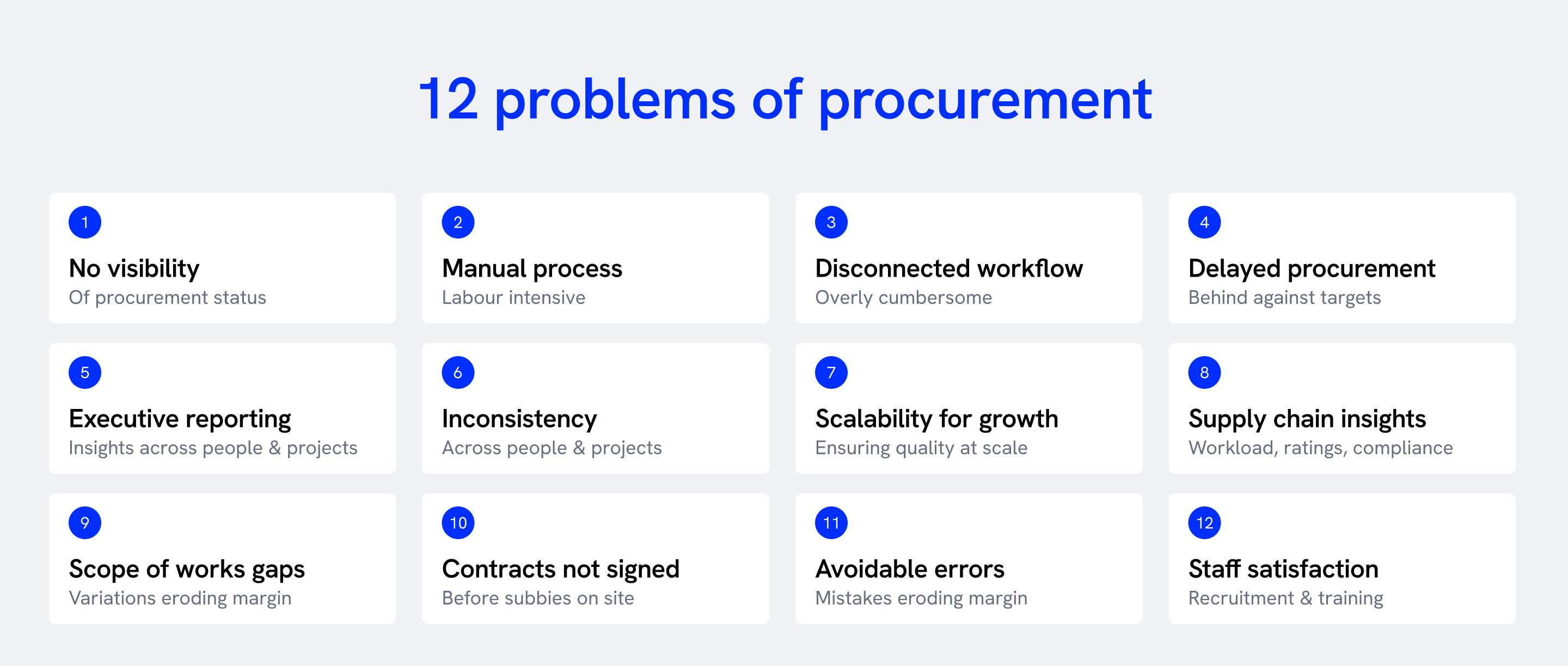
These issues show up every day in The Old Way:
- Disjointed workflows
- Poor supplier visibility
- Administrative errors and inefficiencies
- Limited scalability for business growth
None of this happens because people are bad at their jobs. The systems are flawed and set them up to fail.
Navigating the procurement technology maturity curve
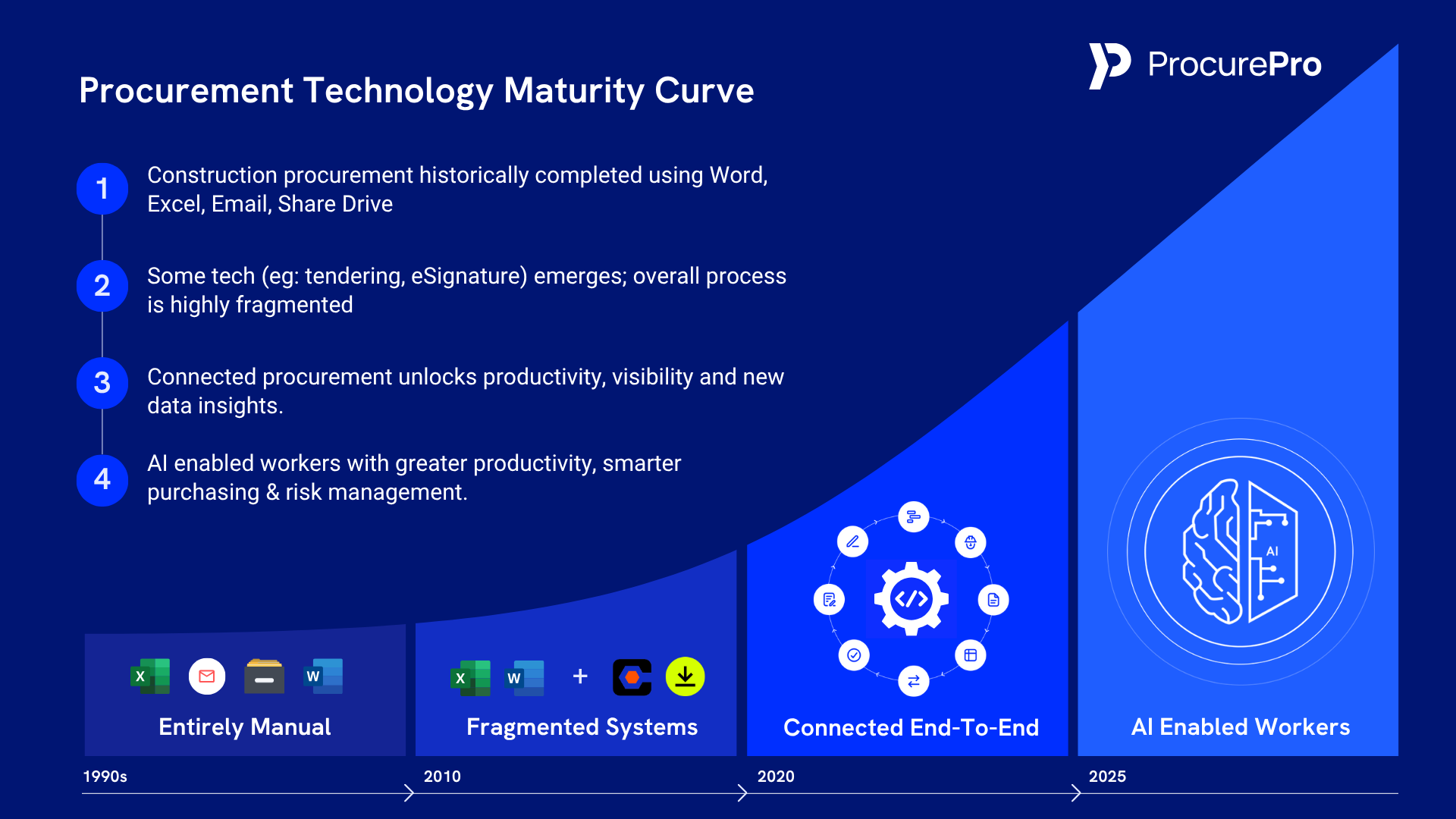
Teams often start with Excel for everything. Later, they add a few bolt-ons like DocuSign or a shared drive. It’s still manual and still patchy.
The next step is linking tasks together so that scopes flow into tenders, comparisons are structured, and contracts don’t get lost in someone’s inbox.
"Structured data is your key to harnessing the real power of AI." — Alastair Blenkin
AI doesn’t work with chaos. It needs consistent formats, a single source of truth, and a system that doesn’t rely on an individual’s memory.
What structured data actually means
- Clear field names: one label for each vendor.
- Consistent formatting: dates, numbers, and pricing entered uniformly.
- Linked workflows: scope, tender, recommendation, and contract tied together.
- Central source of truth: no duplicates, no guessing which version is final.
- Historical records: stored centrally, easy to search and reference.
AI-driven procurement: Sneak peek from our webinar demo
We showed how ProcurePro AI works across real projects.
No fluff or buzzwords — just live demos.
AI-powered estimating handover
When estimators finish pricing, they often move on. A quantity surveyor (QS) must piece together what was priced. Our AI reads the estimating file and creates a summary. It pulls inclusions, exclusions, and tagged risks into a structured format.
Live Pricing Library Insights
AI connects past project data to current procurement decisions. A QS finalising a mechanical tender can search a live pricing library for comparable packages — same scope, similar size, same location. The AI highlights price ranges, typical inclusions, and subbies who delivered that work before.
Intelligent AI Price Comparisons
Upload three quotes. ProcurePro AI compares them in seconds:
- Flags missing inclusions and exclusions.
- Identifies anomalies based on historical data.
- Drafts a summary for internal approval.
If you missed it, you can watch the full webinar here (email required).
The AI maturity curve: Where procurement technology is headed
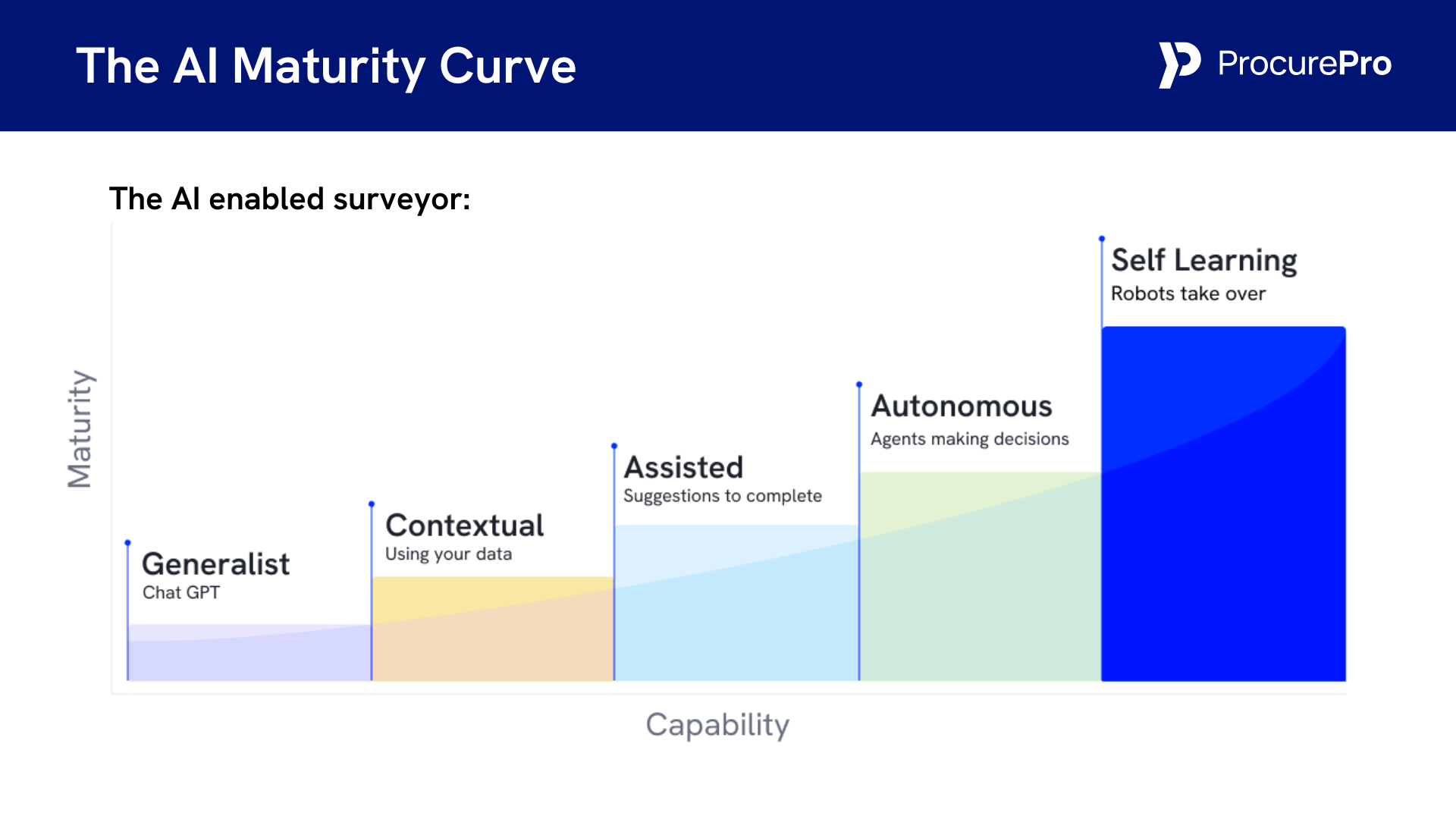
General-purpose AI tools like ChatGPT can tidy up a scope or summarise meeting notes, but they don’t understand construction procurement. They don’t recognise a PC sum or notice a hidden exclusion in your subcontractor quote.
ProcurePro AI was trained on real data from live projects. It tracks the structure and context of procurement, not just the words.
From reactive tools to proactive systems
Teams adopt AI in three stages:
- Descriptive AI: Surfaces data with dashboards and static reports.
- Assisted AI: Highlights issues or anomalies and suggests next steps.
- Autonomous AI: Executes low-risk, repeatable tasks, like drafting standard contracts or auto-filling comparisons.
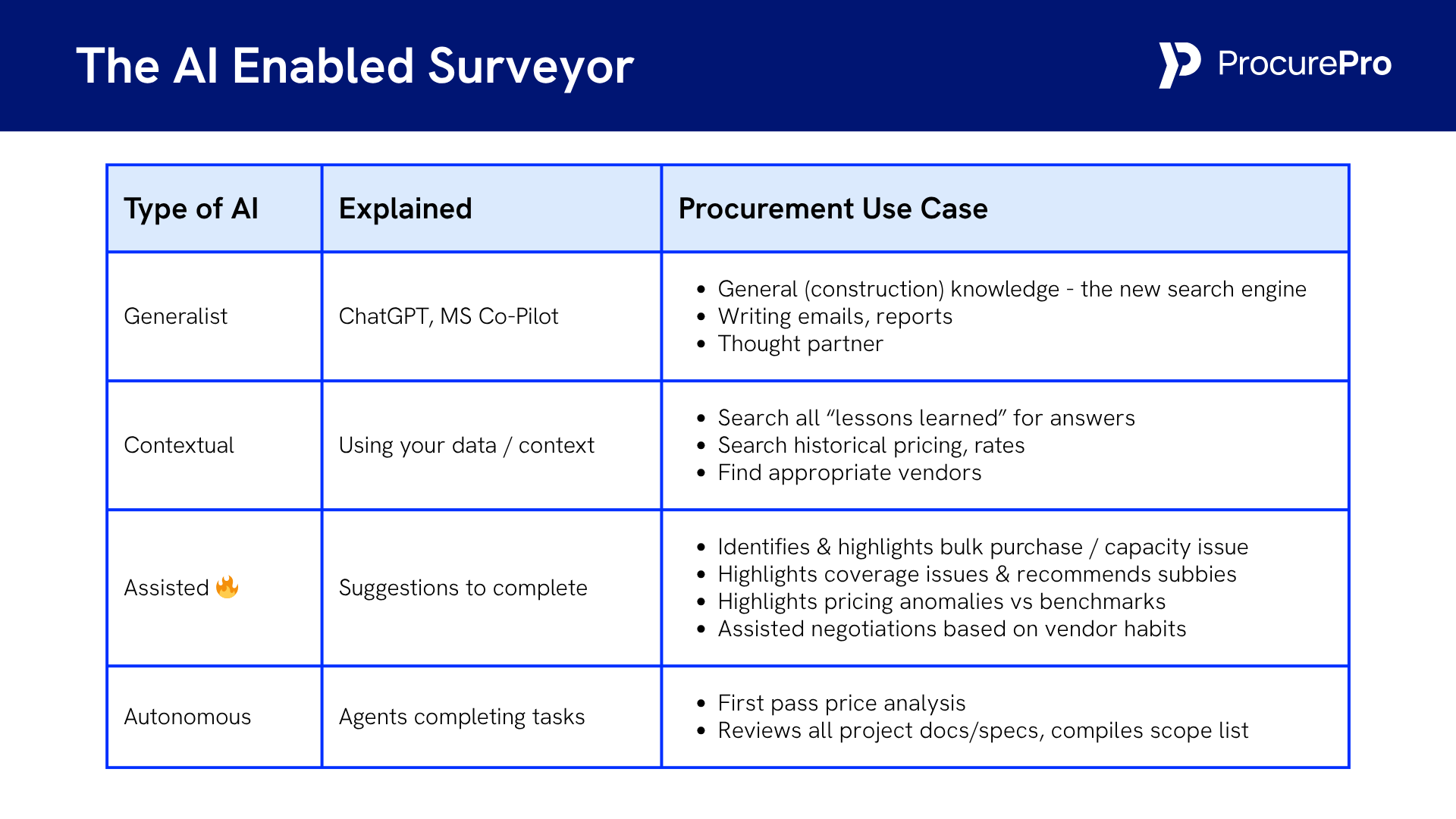
Most construction teams are still mid-journey — bridging spreadsheets and static dashboards. A select few trial autonomous workflows. On 9th June, 2025, Tier 1 contractors in Sydney and Greater London began testing AI that drafts first-pass contracts and flags non-compliant tenders without human input.
Will AI replace quantity surveyors? Debunking common myths
The short answer: no. AI handles repetitive admin so QSs can focus on commercial thinking. Find out more about enhancing efficiency with AI.
"AI empowers QS professionals — it doesn't replace their expertise." — James Metcalfe
AI doesn’t negotiate your deals or align head contract terms with downstream subbies. It shows you if a subcontractor is 18% above the rest, so you can act on it.
What AI changes — and what it doesn’t
- What changes: speed, accuracy, and visibility.
- What stays the same: final decisions, risk calls, commercial oversight.
AI just frees you up for higher-value tasks.
Where AI adds value on real jobs
Some QSs create price comparisons in under five minutes, not hours. This frees time to analyse scope creep, question assumptions, and improve margins.
Others track vendor performance across multiple projects, spotting repeated late starts or clause breaches. The QS still makes the call. AI just delivers timely data.
Practical steps to get started with AI in your procurement team
AI won’t transform how you work until you implement it. That means structure, ownership, and clear goals.
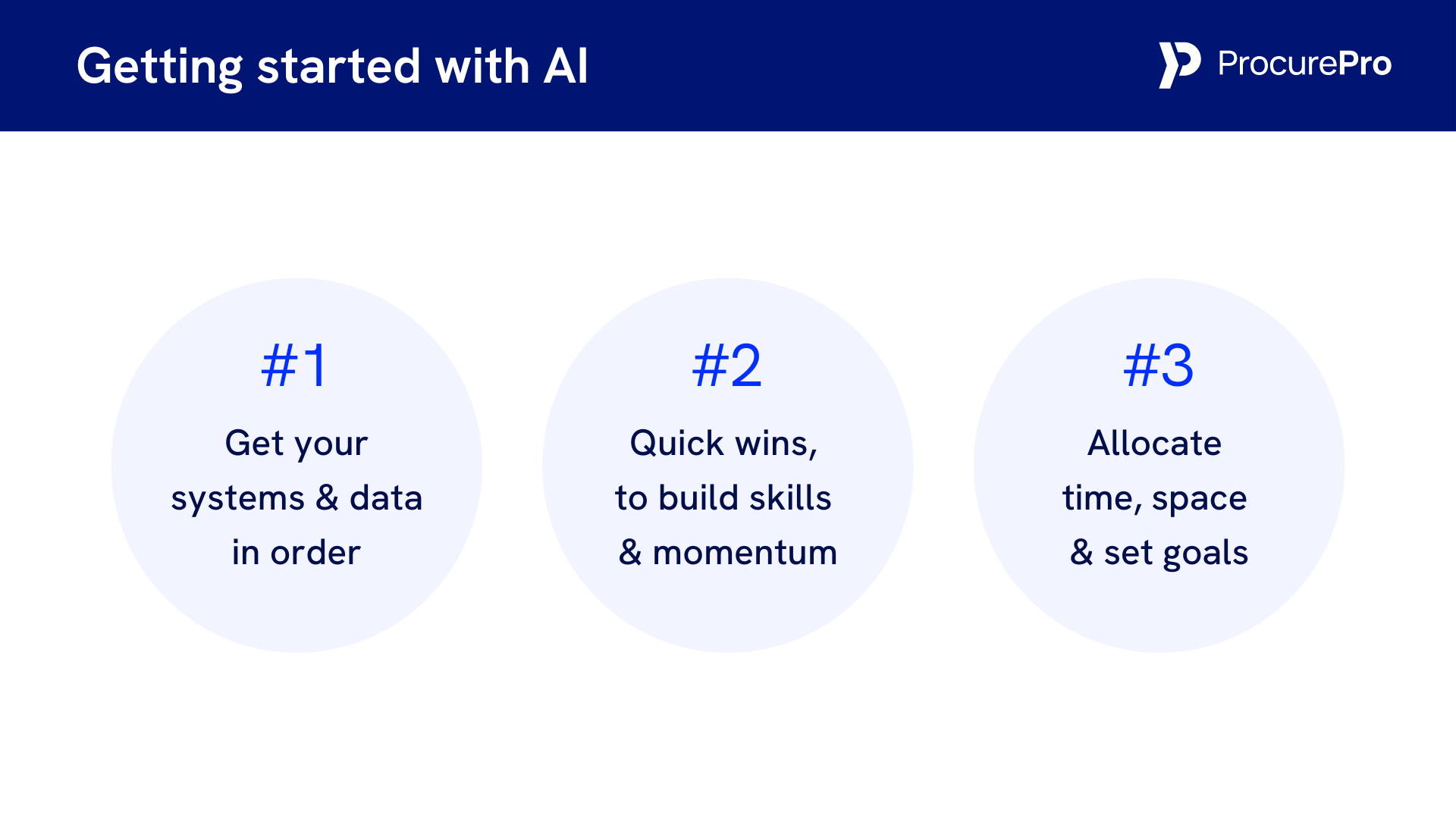
Leadership buy-in
Executives must set the scope and state why it matters (fewer errors, predictable timelines, or better margins). A senior stakeholder should own this outcome — not IT.
Early wins to build momentum
Pick a low-risk, high-friction task. Maybe drafting scopes for repeat trades. Or summarising estimating notes into procurement-ready packages. Learn from procurement process steps to streamline your efforts.
Aim small. Focus on one project or one trade. Practical wins build trust and confidence.
Allocating dedicated resources
AI isn’t a side job. Give one QS or contract administrator two hours each week to test it on a single job. Pair them with a commercial manager who reviews outcomes. Document what works and what doesn’t.
"Innovation demands intention. Give your teams the time and resources to explore." — Alastair Blenkin
Keeping procurement human-centric
AI doesn’t replace relationships. Subcontractors want clear scopes, timely communication, and realistic risk allocations. AI helps you cover the basics so you can build trust.
It also gives you space to think, especially when tensions build or a supplier needs backing, not blame.
Conclusion: Unlock your procurement potential with AI
AI in procurement isn’t about cutting roles. It’s about cutting low-value tasks. Teams protect margins when errors fall. Procurement runs more smoothly when decisions are data-driven.
We showed this live in our webinar — from scoped handovers to quick comparisons and vendor insights.
If you missed it, you can watch the full webinar here (email required) or read more about our mission and team.
